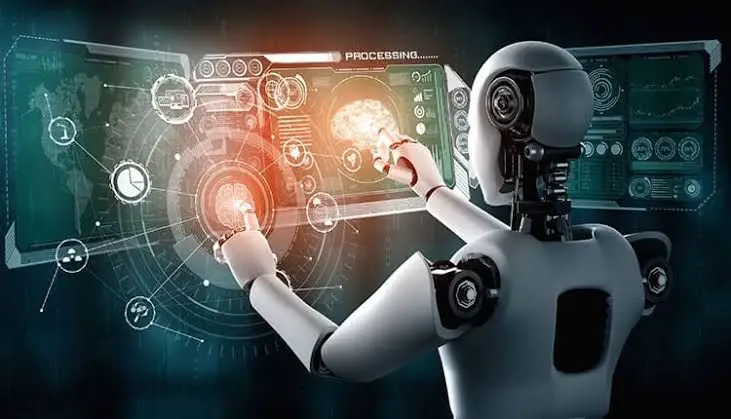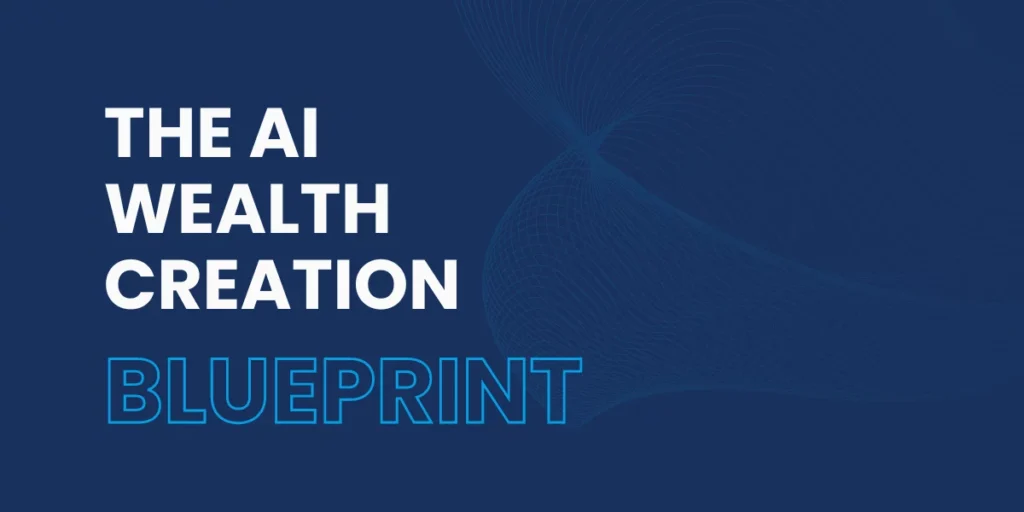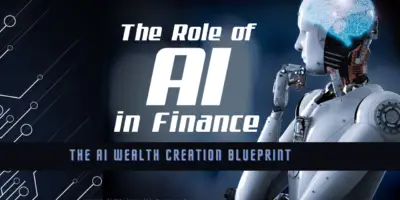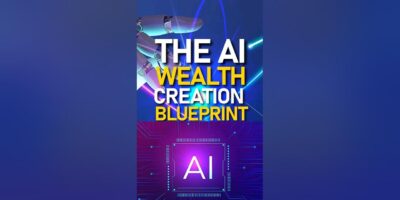The AI Blueprint eBook, one of the top AI wealth creation ebooks on the internet, serves as your roadmap for navigating the transformative power of artificial intelligence. Discover how AI is transforming industries, shaping ethics, and influencing the future itself.
The 21st century isn’t just about smartphones and social media; it’s about the rise of a technological force that’s poised to redefine our world: artificial intelligence (AI).
Imagine machines that learn, reason, and create, not as tools but as partners in innovation. That’s the promise of AI, and the AI Blueprint is your essential guide to understanding its potential and navigating its complexities.
Understanding the AI Blueprint eBook

The AI Blueprint isn’t a single document; it’s a dynamic framework that encompasses principles, best practices, and ongoing discussions. Let’s unpack its key components:
1. The Ethical Imperative:
- Fairness and Non-Discrimination: This principle demands that AI systems treat individuals and groups equitably, avoiding discriminatory outcomes based on factors like race, gender, ethnicity, or socioeconomic status. AI algorithms should be trained on diverse datasets and regularly audited for bias to ensure fair treatment.
- Transparency and Explainability: AI should n’t operate in a vacuum. The decisions made by AI systems should be understandable and traceable. This includes providing clear explanations for AI-generated outputs, especially in high-stakes domains like healthcare or criminal justice.
- Human Agency and Oversight: While AI can automate tasks and make recommendations, ultimate responsibility should remain with humans. AI systems should be designed to augment human capabilities, not replace them entirely. Human oversight is crucial to ensure ethical decision-making and accountability.
- Privacy and Data Protection: AI often relies on vast amounts of personal data. The blueprint emphasizes the need to protect user privacy and data security. This involves obtaining informed consent for data collection, anonymizing or pseudonymizing data where possible, and implementing robust security measures to prevent data breaches.
- Societal Benefit: AI development should be guided by a commitment to create technologies that benefit society as a whole. This includes addressing issues like accessibility, affordability, and inclusivity to ensure that AI’s benefits are broadly distributed.
2. Technical Foundations:
- Robust Algorithms and Models: We should build AI systems on sound mathematical and statistical foundations. The process involves choosing appropriate algorithms for specific tasks, using high-quality training data, and validating models through rigorous testing.
- Reliability and Safety: AI systems should be dependable and safe to use. This involves incorporating measures to prevent errors, handle unexpected situations gracefully, and mitigate potential risks.
- Data Quality and Management: The quality of data used to train AI models is paramount. The blueprint emphasizes the importance of using representative, unbiased datasets and implementing robust data management practices.
3. Societal Impact Lens:
- Economic Impact: AI has the potential to disrupt labor markets and transform industries. The blueprint encourages discussions about potential job displacement, the need for workforce retraining and upskilling, and policies to ensure equitable distribution of AI’s economic benefits.
- Social Impact: AI can influence social interactions, education, healthcare, and other aspects of our daily lives. The blueprint encourages consideration of the potential social implications of AI, both positive and negative.
- Global Impact: AI is a global technology with global implications. The blueprint calls for international collaboration to address issues like AI governance, the potential for AI-powered weapons, and the digital divide.
4. Legal and Regulatory Frameworks:
- Adaptive Regulation: The rapid pace of AI development necessitates agile regulatory frameworks that can keep up with technological advancements while protecting human rights and ethical values.
- Liability and Accountability: When AI systems cause harm or make errors, we need clear legal guidelines to determine who is responsible. The blueprint encourages discussions about liability frameworks for AI.
- Intellectual Property: AI raises questions about ownership of AI-generated content and inventions. Legal frameworks need to adapt to address these issues.
The AI Blueprint is a living document, evolving alongside the technology it seeks to guide. By focusing on ethics, technical excellence, societal impact, and adaptive regulation, it aims to create a future where AI serves as a powerful tool for human progress, not a source of harm or inequality.
The AI Wealth Creation

Artificial intelligence isn’t merely a technological advancement; it’s an economic catalyst, driving wealth creation across industries in profound ways. Here’s how AI is impacting the bottom line and generating new opportunities for wealth creation:
1. Increased Efficiency and Productivity:
- Automation of Repetitive Tasks: AI-powered automation eliminates mundane and repetitive tasks, freeing up human workers to focus on higher-value activities that require creativity, problem-solving, and strategic thinking. This process leads to increased productivity, reduced operational costs, and ultimately, higher profits.
- Optimization of Processes: AI algorithms analyze vast amounts of data to identify patterns and inefficiencies in processes, enabling companies to streamline operations, optimize resource allocation, and make data-driven decisions that enhance efficiency and reduce waste.
- Predictive Analytics: AI-driven predictive models forecast market trends, customer behavior, and potential risks, allowing businesses to make proactive decisions that mitigate risks and capitalize on opportunities.
2. New Revenue Streams and Business Models:
- Product and Service Innovation: AI enables the creation of new products and services that were previously unimaginable, opening up entirely new markets and revenue streams. For example, AI-powered personalized medicine, self-driving cars, and virtual assistants are all examples of innovations that are creating new industries and generating wealth.
- Data Monetization: Companies can monetize the data they collect by using AI to extract valuable insights and sell them to other businesses or use them to develop new products and services.
- Platform Economies: AI is facilitating the rise of platform economies, where businesses connect buyers and sellers, creating value and generating revenue through commissions or fees.
3. Enhanced Decision-Making:
- Data-Driven Insights: AI algorithms process vast amounts of data to uncover hidden patterns and correlations, providing businesses with actionable insights that inform strategic decision-making. This leads to more informed investment choices, optimized marketing campaigns, and better product development strategies.
- Risk Mitigation: AI models assess risk in real-time, allowing businesses to identify and mitigate potential threats before they materialize, safeguarding investments and ensuring financial stability.
- Personalized Experiences: AI enables businesses to deliver personalized experiences to customers, increasing engagement, loyalty, and ultimately, sales.
4. Increased Investment and Funding:
- Attracting Capital: Investors find companies that effectively leverage AI to be innovative and forward-thinking. This influx of capital can fuel growth, research and development, and further AI advancements.
- Venture Capital Boom: The AI sector has become a hotbed for venture capital investment, with billions of dollars flowing into startups and established companies developing AI-powered solutions. This investment is driving innovation and accelerating the adoption of AI across industries.
Industry-Specific Examples:
- Retail: AI-powered recommendation engines personalize product suggestions, boosting sales and customer loyalty.
- Financial Services: Robo-advisors provide automated investment advice at a fraction of the cost of traditional financial advisors, democratizing access to wealth management services.
- Healthcare: AI-powered drug discovery is accelerating the development of new treatments, potentially generating significant revenue for pharmaceutical companies.
- Agriculture: Precision farming techniques powered by AI optimize crop yields, reduce waste, and increase profitability for farmers.
Challenges and Considerations:
- Job Displacement: While AI creates new jobs, it also has the potential to displace workers in certain industries, necessitating reskilling and upskilling initiatives.
- Ethical Concerns: The use of AI raises ethical questions regarding bias, privacy, and accountability.
- Inequality: The concentration of the benefits of AI-driven wealth creation in the hands of a few could exacerbate existing economic inequalities.
The AI Blueprint isn’t just a technological roadmap; it’s a blueprint for economic prosperity. By leveraging AI’s transformative power, businesses across industries are streamlining operations and enhancing customer experiences and unlocking new avenues for wealth creation. While the challenges are real, the potential rewards are immense, making AI a pivotal force in shaping the future of the global economy.
AI Transformation Across Different Industries

Artificial intelligence is not just a technological advancement; it’s a catalyst for economic growth and wealth creation on a global scale. Its ability to automate processes, generate insights from vast datasets, and optimize decision-making is reshaping industries and unlocking new avenues for generating value.
1. Healthcare:
- Diagnosis and Treatment: AI-powered diagnostic tools analyze medical images (X-rays, MRIs, etc.) with remarkable accuracy, often exceeding human capabilities. Such accuracy leads to earlier disease detection and more effective treatment plans. AI also assists in drug discovery by analyzing vast amounts of data to identify potential new treatments.
- Personalized Medicine: AI algorithms analyze individual genetic profiles and medical histories to create personalized treatment plans, maximizing the effectiveness of therapies and minimizing adverse reactions.
- Surgical Robotics: Robots equipped with AI assist surgeons in performing complex procedures with precision and minimal invasiveness, leading to faster recovery times and reduced complications.
- Healthcare Administration: AI streamlines administrative tasks like appointment scheduling, claims processing, and patient record management, freeing up healthcare professionals to focus on patient care.
2. Finance:
- Algorithmic Trading: AI-driven algorithms analyze market data and execute trades at high speeds, often outperforming human traders and optimizing investment portfolios.
- Fraud Detection: AI systems detect fraudulent transactions and suspicious activities in real time, protecting consumers and financial institutions from financial losses.
- Risk Assessment: AI models assess creditworthiness and financial risk, leading to more accurate loan approvals and risk management strategies.
- Customer Service: Chatbots and virtual assistants handle routine customer inquiries, providing 24/7 support and personalized financial advice.
3. Manufacturing:
- Smart Factories: AI-powered robots and automation streamline production processes, reducing costs, improving quality control, and increasing efficiency.
- Predictive Maintenance: AI algorithms analyze sensor data from machines to predict potential failures before they occur, minimizing downtime and costly repairs.
- Supply Chain Optimization: AI optimizes inventory management, demand forecasting, and logistics, leading to reduced waste and improved supply chain resilience.
- Product Design: AI assists in product design by generating design options, simulating performance, and optimizing materials, leading to innovative and efficient products.
4. Transportation:
- Self-Driving Cars: AI is at the heart of self-driving technology, promising to revolutionize transportation by reducing accidents, easing congestion, and improving accessibility.
- Traffic Management: AI-powered systems analyze traffic patterns and optimize traffic flow in real time, reducing congestion and travel times.
- Logistics Optimization: AI optimizes routes for delivery vehicles, reducing fuel consumption and delivery times.
- Public Transportation: AI helps to schedule and manage public transportation systems, improving efficiency and reliability.
5. Customer Service:
- Chatbots and Virtual Assistants: AI-powered chatbots and virtual assistants handle customer inquiries, provide product recommendations, and resolve issues, often leading to improved customer satisfaction and reduced costs.
- Sentiment Analysis: AI analyzes customer feedback and social media conversations to gauge customer sentiment, allowing companies to respond to concerns and improve their products or services.
- Personalized Marketing: AI analyzes customer data to deliver personalized product recommendations and marketing messages, increasing customer engagement and sales.
6. Agriculture:
- Precision Farming: AI-powered drones and sensors collect data on crops and soil conditions, allowing farmers to optimize irrigation, fertilization, and pest control, leading to higher yields and reduced environmental impact.
- Crop Monitoring: AI analyzes satellite imagery to monitor crop health, detect pests and diseases, and predict yields, helping farmers make informed decisions.
- Livestock Management: AI monitors the health and behavior of livestock, detecting early signs of illness and optimizing feeding schedules.
7. Energy:
- Smart Grids: AI optimizes the distribution of electricity, balancing supply and demand in real time and improving energy efficiency and grid reliability.
- Renewable Energy Integration: AI integrates renewable energy sources like solar and wind into the grid, managing their intermittent nature and optimizing energy production.
- Energy Storage: AI manages energy storage systems, optimizing the use of stored energy and reducing the need for fossil fuel-based power generation.
AI Wealth Creation Blueprint

Artificial intelligence isn’t just transforming how we work and live; it’s revolutionizing how we create and manage wealth. The AI Wealth Creation Blueprint is a dynamic framework that leverages the power of AI to optimize financial strategies, manage risks, and generate returns in unprecedented ways.
Key Components of the AI Wealth Creation Blueprint Book:
- AI-Powered Investment Strategies:
- Algorithmic Trading: AI algorithms analyze massive amounts of market data in real-time, executing trades with speed and precision far beyond human capabilities. These algorithms can identify patterns, exploit market inefficiencies, and capitalize on short-term price movements, potentially generating significant profits.
- Portfolio Optimization: AI-powered tools assess risk tolerance, financial goals, and market conditions to create personalized investment portfolios. These portfolios are dynamically adjusted based on real-time data, maximizing returns while managing risk.
- Robo-Advisors: Automated investment platforms use AI to provide low-cost, personalized investment advice and portfolio management to a wider range of investors.
- Risk Management and Fraud Detection:
- Credit Risk Assessment: AI models analyze vast amounts of data to assess creditworthiness more accurately than traditional methods, reducing defaults and improving lending decisions.
- Fraud Detection: AI algorithms detect fraudulent transactions and suspicious activity in real-time, protecting financial institutions and consumers from losses.
- Market Risk Analysis: AI tools analyze market trends, economic indicators, and news sentiment to assess market risks and predict potential disruptions. This feature helps investors make informed decisions and protect their investments.
- Financial Insights and Decision Support:
- Sentiment Analysis: AI algorithms analyze news articles, social media posts, and other sources to gauge market sentiment, helping investors understand how public opinion might impact markets.
- Predictive Analytics: AI models use historical data and machine learning to predict market trends, stock prices, and economic indicators, providing valuable insights for investment decisions.
- Financial Forecasting: AI tools forecast financial performance, enabling businesses to optimize budgeting, cash flow management, and resource allocation.
- Financial Inclusion:
- Micro-Lending: AI-powered platforms assess creditworthiness and provide microloans to individuals and small businesses in underserved communities, promoting economic growth and financial inclusion.
- Personalized Financial Advice: AI tools offer accessible and affordable financial advice to individuals who may not have access to traditional financial advisors.
- Financial Literacy Tools: AI-powered educational platforms provide interactive financial literacy courses and simulations, empowering individuals to make informed financial decisions.
The Future of AI in Wealth Creation:
The AI Wealth Creation Blueprint ebook is still evolving, with new applications and innovations constantly emerging. Here are some key trends to watch:
- Decentralized Finance (DeFi): AI is playing a role in the growing DeFi space, automating smart contracts, managing decentralized exchanges, and optimizing yield farming strategies.
- Cryptocurrency Trading: AI-powered trading bots are increasingly used to execute cryptocurrency trades, capitalizing on the volatility of digital assets.
- Alternative Data: AI is being used to analyze alternative data sources like satellite imagery, social media trends, and consumer spending patterns to gain unique insights into market trends and investment opportunities.
The AI Wealth Creation Blueprint Book in Action:
Real-world examples illustrate how AI is already transforming wealth creation:
- Hedge Funds: Many hedge funds use AI algorithms to execute trades and manage portfolios, often outperforming traditional investment strategies.
- Wealth Management Firms: Wealth managers are using AI tools to provide personalized investment advice and portfolio management to clients at scale.
- Fintech Startups: Numerous fintech startups are leveraging AI to develop innovative financial products and services, democratizing access to investment opportunities and financial advice.
The AI Wealth Creation Blueprint Ebook is a roadmap to a future where AI empowers individuals and institutions to achieve financial success. By leveraging AI’s capabilities in investment, risk management, and financial insights, we can unlock new opportunities, manage risks more effectively, and democratize access to financial services.
However, it’s crucial to approach AI with a focus on ethics, transparency, and responsible use to ensure that its benefits are shared broadly and equitably.
Ethical Crossroads in the AI Wealth Creation Blueprint Ebook
The AI Wealth Creation Blueprint ebook brings with it immense potential for financial growth and innovation. However, it also raises a myriad of ethical concerns that demand careful consideration and proactive solutions.
- Bias and Discrimination:
- Data Bias: AI algorithms learn from historical data, which may contain biases reflecting societal inequalities. AI systems may perpetuate and amplify these biases if not addressed, resulting in discriminatory outcomes in lending, investment decisions, and financial product offerings.
- Algorithmic Bias: Due to their design or training methods, AI algorithms can develop biases even with unbiased data. These biases can lead to unfair treatment of certain groups, denying them access to financial opportunities or charging them higher interest rates.
- Mitigating Bias: Addressing bias requires diverse and representative datasets, careful algorithm design, ongoing monitoring for discriminatory outcomes, and regular audits to ensure fairness.
- Transparency and Explainability:
- Black Box Algorithms: Many AI models, especially deep learning models, are considered “black boxes” because their decision-making processes are opaque. This lack of transparency makes it difficult to understand why an AI system made a particular decision, raising concerns about accountability and fairness.
- Explainable AI (XAI): The development of XAI is crucial for building trust in AI-powered financial systems. XAI techniques aim to provide clear and understandable explanations for AI decisions, making them more transparent and accountable.
- Financial Inequality and Market Manipulation:
- The Wealth Gap: AI-powered trading algorithms can potentially exacerbate existing wealth disparities by giving an advantage to those with access to sophisticated technology and financial resources. Such developments can lead to a concentration of wealth and increased inequality.
- Market Manipulation: Through high-frequency trading, spoofing, and other tactics, AI algorithms can manipulate markets. These practices can disrupt market fairness, disadvantage smaller investors, and harm the overall stability of financial systems.
- Regulatory Measures: To prevent market manipulation and guarantee fair access to financial markets for all participants, robust regulations and market surveillance are required.
- Data Privacy and Security:
- Personal Financial Data: AI-powered financial systems rely on vast amounts of sensitive personal financial data. Ensuring the privacy and security of this data is paramount to protect individuals from identity theft, fraud, and other financial harms.
- Data Breaches: The risk of data breaches and cyberattacks is a significant concern, as the consequences can be devastating for individuals and financial institutions. Robust cybersecurity measures and data protection protocols are essential.
- Algorithmic Accountability:
- Who is Responsible?: When AI systems make financial decisions with significant consequences, it’s not always clear who is accountable for the outcomes. Should it be the developers, the users, or the institutions deploying the algorithms? Establishing clear lines of accountability is essential for addressing any negative consequences and ensuring fair recourse for those affected.
- Regulatory Frameworks: Legal and regulatory frameworks need to evolve to address the unique challenges posed by AI in finance. These frameworks should clearly define who is responsible for AI decisions, establish liability for algorithmic errors or biases, and provide mechanisms for redress in case of harm.
Navigating the Ethical Crossroads:
Addressing these ethical challenges requires a multi-faceted approach:
- Ethical AI Development: Incorporating ethical considerations into the design and development of AI algorithms from the outset is crucial. This includes using diverse and representative datasets, ensuring transparency and explainability, and building mechanisms for human oversight and intervention.
- Robust Regulation: To govern the use of AI in finance, protect consumer rights, and ensure market integrity, we need clear and enforceable regulations. These regulations should address issues like bias, transparency, market manipulation, and data privacy.
- Industry Standards: Developing industry-wide ethical standards and best practices can help guide responsible AI development and deployment in the financial sector.
- Education and Awareness: Raising awareness among investors, financial professionals, and the public about the potential risks and ethical implications of AI in finance is essential for fostering informed decision-making and responsible use of AI technologies.
The AI Wealth Creation Blueprint ebook holds immense promise for revolutionizing finance, but it’s crucial to navigate the ethical crossroads with care and foresight. By proactively addressing these challenges, we can harness the power of AI for good, ensuring that its benefits are shared equitably and responsibly.
Gazing into the AI Future: A Panorama of Possibilities and Perils

The AI landscape is evolving at an unprecedented pace, with the potential to reshape our world in ways both exhilarating and daunting. Let’s delve into the multifaceted future of AI:
1. The Era of Superintelligence:
- Artificial General Intelligence (AGI): While current AI systems are specialized in specific tasks, the emergence of AGI—machines with human-level intelligence across a wide range of domains—is a long-term goal. AGI could revolutionize problem-solving, scientific discovery, and even our understanding of consciousness.
- The Singularity: Some experts predict a point known as the Singularity, where AI surpasses human intelligence, leading to exponential technological advancements. The implications of this event are both exciting and uncertain, raising questions about human-AI relationships and the very nature of our existence.
2. AI-Driven Innovation:
- Scientific Breakthroughs: AI is accelerating research in fields like drug discovery, materials science, and climate modeling. Machine learning algorithms can analyze vast datasets, identify patterns, and generate hypotheses, leading to breakthroughs that would take humans years to achieve.
- Personalized Experiences: AI is tailoring products, services, and content to individual preferences and needs, enhancing customer experiences and driving innovation across industries.
- Social Impact: AI-powered tools are being used to address global challenges like poverty, disease, and climate change. For example, AI is being used to optimize resource allocation in developing countries, diagnose diseases in remote areas, and predict natural disasters.
3. Ethical and Societal Concerns:
- Bias and Discrimination: Algorithmic bias remains a pressing concern, as AI systems trained on biased data can perpetuate and even amplify existing inequalities. Addressing bias requires diverse and representative datasets, transparent algorithms, and ongoing ethical oversight.
- Job Displacement: The automation potential of AI raises concerns about job losses and economic disruption. While AI will undoubtedly create new jobs, the transition will require reskilling and upskilling the workforce to adapt to the changing landscape.
- Existential Risks: The development of superintelligent AI raises existential questions about the potential for misuse, unintended consequences, and even the loss of human control. Ensuring AI alignment with human values is a paramount concern for the future.
4. Regulation and Governance:
- Global Collaboration: The development and deployment of AI require international collaboration to establish ethical guidelines, technical standards, and legal frameworks that address the unique challenges posed by AI.
- Adaptive Regulation: The rapid pace of AI innovation necessitates adaptive regulatory frameworks that can keep pace with technological advancements and address emerging risks.
- Public Engagement: Open and transparent dialogue about AI’s potential benefits and risks is essential to ensure public trust, foster ethical development, and guide responsible AI deployment.
5. The Human-AI Partnership:
- Augmented Intelligence: People increasingly view AI as a tool to enhance human capabilities, rather than as a replacement for them. AI can automate repetitive tasks, provide insights and recommendations, and enhance decision-making, allowing humans to focus on creativity, critical thinking, and complex problem-solving.
- Collaboration: The future of AI lies in collaboration between humans and machines. By working together, we can leverage the strengths of both to achieve outcomes that neither could achieve alone.
- Human Values: It’s essential to ensure that AI systems are aligned with human values, such as fairness, transparency, and accountability. Such an endeavor requires ongoing ethical considerations and responsible design.
Conclusion: The Path Forward
The AI future is not predetermined; it’s a path we are actively shaping through our choices, investments, and policies. By embracing a proactive, ethical, and collaborative approach, we can harness the transformative power of AI to create a better world for all while mitigating its potential risks.
The AI Blueprint serves as a guide, fostering responsible innovation and ensuring that AI technologies are developed and deployed in ways that benefit humanity as a whole.
The AI Blueprint FAQs: Your Questions Answered
1. What exactly is the AI Blueprint?
The AI Blueprint is a comprehensive framework that guides the ethical development, deployment, and regulation of artificial intelligence (AI). It encompasses principles, best practices, and ongoing discussions about how to harness AI’s power for good while mitigating its potential risks.
2. Why is the AI Blueprint important?
The AI Blueprint is crucial because AI is rapidly transforming our world. It’s essential to have a roadmap for responsible AI development that prioritizes ethics, transparency, fairness, and human well-being. The blueprint helps ensure that AI technologies are used to benefit society as a whole.
3. Who is involved in creating the AI Blueprint?
The AI Blueprint is not a single document created by one entity. It’s a collaborative effort involving AI researchers, developers, policymakers, ethicists, and representatives from various sectors and industries. It’s an ongoing conversation about how to shape the future of AI.
4. What are the key principles of the AI Blueprint?
The key principles include:
- Ethical Development: Building AI systems that are fair, unbiased, transparent, and accountable.
- Technical Excellence: Ensuring that AI systems are accurate, reliable, and safe through rigorous testing and quality data.
- Societal Impact: Considering the broader implications of AI on employment, economic growth, social well-being, and global governance.
- Legal and Regulatory Frameworks: Developing adaptive legal frameworks to govern AI use, protect human rights, and address potential risks.
5. How does the AI Blueprint address ethical concerns about AI?
The blueprint emphasizes addressing ethical concerns like algorithmic bias, discrimination, job displacement, privacy, and securitIt promotes transparency, explanation, and fairness in AI systems.
6. What are some examples of how the AI Blueprint is being applied?
Various sectors are applying the AI Blueprint:
- Healthcare: Developing AI-powered diagnostic tools that are transparent and unbiased.
- Finance: Creating AI-based credit scoring models that are fair and non-discriminatory.
- Transportation: Ensuring self-driving cars prioritize safety and ethical decision-making.
- Education: Designing AI-powered educational tools that respect student privacy and avoid perpetuating biases.
7. Is the AI Blueprint a legally binding document?
The AI Blueprint itself is not a legally binding document. However, it informs the development of laws, regulations, and industry standards related to AI.
8. What are some challenges in implementing the AI Blueprint?
Challenges include:
- Rapid Technological Advancements: Keeping the blueprint updated with the latest AI developments is crucial.
- Global Collaboration: Ensuring international cooperation and agreement on ethical AI principles.
- Balancing Innovation and Regulation: Finding the right balance between fostering AI innovation and implementing necessary regulations.
9. How can I get involved in the AI Blueprint discussion?
You can get involved by:
- Staying informed: Follow news and developments in AI ethics and governance.
- Engaging in discussions: Participate in online forums, conferences, and workshops on AI ethics.
- Supporting organizations: Contribute to or volunteer with organizations working on responsible AI development.
10. What is the ultimate goal of the AI Blueprint?
The ultimate goal of the AI Blueprint is to ensure that AI is developed and used in ways that benefit humanity as a whole, promoting fairness, equity, and human well-being while mitigating potential risks.
Please let me know if you have any other questions in the comment section!
Discover more from Digital Wealth Guru
Subscribe to get the latest posts sent to your email.








Comments